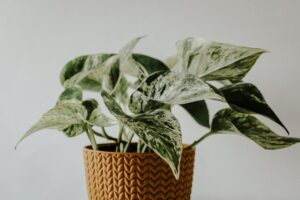Pothos Plant/ Devil’s Ivy: Propagation, Types and Care

Devil’s Ivy, also known as Devil’s Vine or Speaking Plant or Pothos or Money plant, is one of the best indoor plants cultivated mainly for aesthetic purposes and air purification. Green leaves with a yellow and pale green stripe on the dorsal leaf surface are considered the best variety of Devil’s Ivy.
Did you know pothos are almost impossible to kill even in the complete absence of the sun? And even, extremely easy to care for.
Introduction
Originated in the Solomon Islands near France, this beautiful ornamental plant variety is also known as the ‘Lucky plant’ as it is believed to bring wealth, prosperity, health, and happiness.
Belonging to the Araceae family in the genus Epipremnum, the average life span of this lush vine is from 5-10 years.
How to grow?
Speaking plant takes almost eight weeks for its root system to establish well.
Devil’s Ivy thrives well in areas receiving indirect sunlight, viz. near window panes.

Known best for their aesthetic importance in the modern world, Devil’s Ivy are propagated as hanging plants and pole plants. Including containers and baskets, these plants can also grow outdoors or in a hanging basket.
These plants can grow up to 40 feet in height.
Propagation
The best method for propagation of devil’s ivy is via stem cutting.
Give a slanting cut to the stem from the main plant and let the stem dry for 3-4 hours.
Later, place the cutting in a jar or vase full of clean water, ensuring that the water covers the bottom 1 or 2 nodes.
After 15 – 30 days, the root emergence shall begin. You may now transfer the plant to the soil.
If the propagation is to be done by seed, take seeds with >12% moisture content and >95% physical purity.
Pothos seeds are tough to find and could produce any variegation. So, it is very best to plant Pothos using cuttings than seeds.
Watch the video below for easy and fast multiplication of pothos plant by yourself.
Cultivars
Different kinds of pothos are:
Marble Queen Pothos
- This species of Devil’s Ivy can survive in low light conditions, but it thrives real good if given medium to bright light.
- The more light, the more is the variegation. But, Direct sunlight will burn the foliage.
- These perform best in moderate to dry soil.

Neon Pothos
- Filtered light or fluorescent light conditions is best for this vigorous growing variety.
- Avoid hot, direct afternoon sun, and it is best to plant these in a hanging basket where their trailing vines can fall freely.

Jessenia Pothos
- These varieties are rare and hard-to-find varieties of Pothos.

Manjula Pothos
- Known best for their variegated white and green leaves, these varieties are best known for their ease of care and rapid growth.
Pearls and Jade Pothos
- These varieties are one of the new cultivars of Marble queen, having their own typical variegations.
Silver / Satin Pothos

- Native to tropical Asian rainforests, these cultivars could grow up to 10 ft. (3 m) in height with their heart-shaped leaves.
Soil
Ivy can tolerate soils that are occasionally dry to occasionally wet.
When planted outdoors, devil’s ivy flourishes in a wide range of soil conditions, from acidic to alkaline.
If you’re growing it in containers, an all-purpose, peaty potting mix that drains well is adequate for proper growth.
Use 100% well-decomposed compost fertilizers only.
Climate and environment
Devils Ivy’s enjoy muggy weather and not misty one.
The best optimum condition for Pothos cultivation is 70- 90°F. Minimum temperatures below 70°F and maximum temperatures above 90°F will retard growth.
If the well-drained condition is not available, the root rotting is easily observed.
Irrigation
Pothos sweating is the process of guttation in which water drips off leaves. It usually occurs as a result of high humidity or overwatering. Once this occurs, reduce irrigation for few days.
Overwatering leads to the yellowing or browning of leaves.
The plants thrive best when the soil they are growing in is allowed to dry between waterings.
Moreover, pothos can also be grown on the water with nutrients added, but water should not be highly chlorinated.
Inter-culture and weed control
Devil’s Ivy is barely cultivated uplands where the weeding rate is high. But these are cultivated in containers where foreign seeds or varieties are rare.
If soil is rich in biological impurities, the first weeding operation should be done 20-25 days after sowing.
Again, the second weeding operation should be done within 20-25 days of transplanting.
Apart from this blanket recommendation, it is best to perform a weeding operation whenever the density of weed emergence in the field impedes the efficient growth of the plant.
The lesser the weed, the healthier the plant, as weeds tend to compete with the main plant in terms of space, fertilizers, and nutrient requirements.

Planting tips:
If the temperature is extreme or the soil is very dry, or the ivy plant is not producing new leaves, one should not apply fertilizers.
Transplant young plants to a big-containers only in the evening because, during the evening, carbohydrate accumulation is high because of the photosynthesis the plant has done all day.
It can grow up to 40 feet long in the landscape, whereas indoor plants typically range from 6 to 8 feet in length if left unpruned.
One can even plant Devil’s Ivy in nutrient-rich water media but make sure the water is not highly chlorinated.
The less pruning you do to the money plant, the bushier it becomes.
Major diseases and Control:
1. Bacterial Leaf Spot
Symptoms: Rapidly spreading water-soaked lesions are observed anywhere on leaves, leaf spots characterized by a yellow border. Under wet conditions, the centers of these spots tend to fall.
Control: Mechanical control by plucking the leaves. Apply streptomycin sulfate (Agri-Strep 21.2%) on leaves. Use clean cuttings and strict sanitation.
2. Pythium root rot

Symptoms: Poor rooting with yellow leaves, mushy black rot in stem extending from the cut end into the upper portions of the stem, and leaves. Root and stem rots usually occur in patches where it spreads into uninfected cuttings.
Control: Use pathogen-free plant varieties and sterilized potting media. Reduce water applications to the minimum level for well-rooting to reduce root and stem rot diseases.
3. Rhizoctonia root rot
Symptoms: Rhizoctonia mycelia are usually reddish-brown in color and have the consistency of a spiderweb.
Control: Chemical control by using various types of fungicides like Karathene.
Major insects and nematodes control:
1. Mealybugs

Symptoms -Mealybugs appear as white, cottony masses in leaf axils on the lower surfaces of leaves and the roots. The infested plants become stunted, which eventually begin to die.
Control -Systemic control using insecticides is the best using soil drenching. When pesticides are applied to the soil, care must be taken to ensure that the pots have good drainage.
2. Mites

Symptoms – When Spider mites attack, the damaged foliages turn yellow and become speckled. Defoliation greatly increases at the later stage of the attack, which eventually leads to plant death.
Control – Inspecting growing areas timely and adopting biological control is the best way to minimize the number of spider mites greatly.
Benefits of cultivation:
- Pothos can work well as an indoor air purifier.
- Devils ivy also releases positive vibrations as per spiritual science.
- It is highly used for aesthetic purposes.
Toxicity
Since all portions of devil’s ivy are toxic, one must keep it away from the reach of children or pets.
Some people also have an allergic reaction to the sap, so it is recommended to prune the plant wearing gloves.
Devil’s Ivy or Pothos is a wonderful plant to grow indoors. Besides having aesthetic value, it also purifies the air. So, don’t forget to include pothos while designing your interior. Also, most importantly, do not forget to leave a comment and give feedback on this article. Happy Gardening!
Read more on planting and care of the indoor plant: Jade plant.
